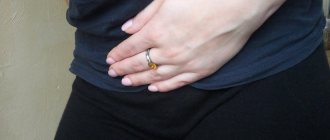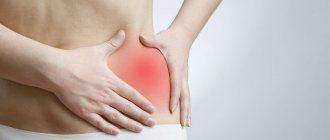Heaviness in the right hypochondrium is a symptom of a certain pathological process, most often of a gastroenterological nature. However, diseases of other organs and systems of the body are no exception.
Sometimes this symptom is not a sign of a pathological process, for example, with excessive physical exertion. If a feeling of heaviness in the right hypochondrium is constantly observed and additional symptoms are present, you should consult a doctor for qualified medical help. Self-medication or ignoring symptoms is unacceptable.
Etiology
Heaviness in the right hypochondrium may be present in the clinical picture of the following pathological processes:
- diseases of the biliary tract;
- liver diseases;
- damage to the right half of the diaphragm;
- pathological processes in the area of the right adrenal gland;
- cholelithiasis;
- intercostal neuralgia;
- diseases that affect the right lung;
- appendicitis;
- lumbar osteochondrosis;
- cardiovascular pathologies.
In addition, heaviness under the right rib can be caused by external negative factors:
- hypothermia;
- excessive physical activity;
- poor nutrition – the manifestation of this symptom is likely after a heavy meal;
- severe bruise.
If the heaviness in the right hypochondrium is not caused by a pathological process, then once the provoking factor is eliminated, the symptom disappears. However, you need to understand that prolonged exposure to certain causes can lead to the development of diseases with this symptom.
Symptoms
If heaviness and pain in the right hypochondrium are not justified by a pathological process, then additional symptoms, as a rule, are absent.
In gastroenterological diseases, heaviness in the area of the right hypochondrium may be accompanied by the following symptoms:
- bloating;
- changes in the frequency and consistency of stool; stool may be watery and contain particles of undigested food. Attacks of diarrhea can occur up to 10 times a day;
- loss of appetite;
- rumbling in the stomach, flatulence;
- heartburn, belching with an unpleasant odor.
In liver diseases, heaviness and pain in the right hypochondrium in front are accompanied by the following symptoms:
- nausea, vomiting often mixed with bile;
- feeling of fullness in the right hypochondrium;
- yellowness of the skin, which is a specific sign of hepatitis;
- weight loss due to loss of appetite and frequent bouts of diarrhea;
- weakness, increased fatigue;
- irritability, sudden mood swings;
- low-grade body temperature;
- liver enlargement.
Often, heaviness in the area of the right hypochondrium can be a sign of the onset of the inflammatory process of the appendix, which manifests itself in the following clinical picture:
- nausea with vomiting;
- increased, as the pathological process worsens, high body temperature;
- sharp, cramping pain in the abdomen;
- profuse sweating;
- high blood pressure.
This human condition is characterized by a high risk of death.
If the cause of the development of this symptom is osteochondrosis of the lumbar region, then heaviness in the area of the right hypochondrium is almost always accompanied by pain and the following symptoms:
As the pathological process worsens, the clinical picture may be accompanied by symptoms of hepatic colic. The heaviness in the right hypochondrium is constant, which intensifies with minimal physical exertion.
If this symptom is a manifestation of cardiovascular pathologies, then the following specific signs are likely to occur:
- dyspnea;
- heaviness in the hypochondrium, which is accompanied by pain;
- unstable blood pressure;
- feeling of tightness in the chest area;
- nausea, rarely with bouts of vomiting;
- increased sweating.
The presence of any of the above-described clinical pictures requires immediate medical attention, since timely diagnosis significantly increases the effectiveness of treatment and the chances of a full recovery. Self-medication is unacceptable.
Types of pain
Pain on the side on the right side under the ribs often indicates inflammatory processes in the liver (other symptoms of a diseased liver can be found in this article), gallbladder, and also kidneys or intestines, which can be a consequence of injury. Painful sensations can be pulling, aching or sharp, stabbing, cutting and unbearable. Their location can be local or spread over the entire side. Unpleasant sensations can radiate pain to the stomach, ribs and even to the shoulder.
Such sensations indicate the following pathologies:
- colic in the kidneys is characterized by acute pain on the right side;
- diseases in the chronic form of the abdominal area are manifested by dull pain;
- stabbing sensations indicate inflammation;
- inflammation of the mucous membrane of the large intestine and gallbladder is manifested by aching painful sensations on the right.
Diagnostics
In order to establish the cause of such a symptom, it is necessary to conduct an examination of the patient, which includes laboratory and instrumental methods. A preliminary physical examination is carried out with palpation of the painful area, collection of complaints, medical history and life history.
Laboratory diagnostic methods include:
- general clinical analysis of blood, urine and feces;
- blood chemistry;
- liver tests;
- tests for the presence of viral hepatitis;
- fecal occult blood test, etc.
Instrumental diagnostic methods for this symptom include:
- Ultrasound of the abdominal organs;
- CT and MRI;
- X-ray of the stomach with a contrast agent;
- coprogram;
- gastroduodenography;
- cholecystopancreatography;
- microscopic examination of liver biopsy.
Based on the examination results, the etiology of this symptom is established and the optimal treatment tactics are selected.
Treatment
Basic therapy will depend on the underlying factor. Drug treatment may include taking the following medications:
- antispasmodics;
- painkillers;
- non-steroidal anti-inflammatory drugs;
- hepatoprotectors;
- to improve gastric motility;
- probiotics;
- vitamin and mineral complexes.
It is imperative to follow a gentle diet, which involves the complete exclusion of fatty, fried foods, and alcohol. The patient should eat frequently, but in small portions, with an interval of 2–3 hours between meals. In case of chronic diseases, adherence to the diet must be constant, even in the stage of stable remission.
Prevention
For prevention purposes, you should adhere to the following recommendations:
- eat a properly balanced diet;
- undergo a preventive medical examination annually;
- treat all diseases in a timely manner.
Thus, it is possible, if not to exclude, then to minimize the risk of developing diseases with this symptom in the clinical picture.
Heaviness in the right hypochondrium is a common reaction of the body to poor diet, bad habits, and imbalance of loads.
At the same time, such manifestations, in combination with other symptoms, help make a diagnosis when identifying diseases of various organs and systems.
Heaviness in the right hypochondrium
Pressure in the area of the right hypochondrium periodically occurs in absolutely healthy people, under the influence of external factors.
But, it is necessary to take into account that many different organs are located under the ribs on the right. Including:
- liver;
- bud;
- part of the diaphragm;
- duodenum;
- gallbladder;
- small intestine;
- ascending colon;
- pancreas.
If there is a dysfunction or injury to any of them, the body reacts to this with the appearance of discomfort. In addition, pain caused by negative changes in other departments sometimes “refers” to this area. For example, with pneumonia or heart pathologies.
Causes
The causes of heaviness under the ribs and a feeling of fullness do not necessarily indicate a health hazard. Discomfort not caused by illness may appear:
- during pregnancy (usually in the last trimester) due to pressure from the enlarged uterus on nearby organs;
- in women, stabbing in the side during hormonal imbalances during menopause or during PMS;
- after physical exercise, the cause of stabbing pain under the ribs is excess blood flow in the liver;
- Bloating occurs as a result of eating fatty, spicy foods or alcoholic beverages. This is due to an increased load on the liver and other gastrointestinal organs;
- Severe stress can trigger a spasm that causes pressure in the side.
In all of these cases, negative sensations pass quickly after the provoking factors are eliminated.
When pain in the right side is felt regularly, the disease is most likely developing. There are a lot of pathologies with similar symptoms. Only a doctor can determine the exact cause of discomfort using laboratory diagnostics. The localization of pain and additional signs play an important role in determining the disease.
Feeling of fullness under the ribs in front
A feeling of heaviness and fullness under the ribs in the front most often indicates problems with the liver. Such as:
Pathologies of this organ are characterized by a gradual increase in symptoms. This is explained by the fact that the liver cells themselves lack nerve endings (they are present only in the membrane). Pain under the rib in the front occurs at the stage of changes in the structure of the parenchyma, due to which the organ expands and puts pressure on the capsule surrounding it.
Dull or sharp pain with a stomach ulcer is felt mainly in the front. In this case, the discomfort becomes stronger due to the consumption of fatty, spicy foods or after physical activity.
After meal
If pressing sensations in the right hypochondrium occur after eating, their cause is most often a dysfunction of the gallbladder or its ducts.
This organ stores excess bile produced by the liver to digest food. When inflammation of the gallbladder (cholecystitis) occurs, heaviness and pain in the right side intensifies some time after eating. Dull pain indicates a chronic course of the disease (the acute form is characterized by pain and burning).
The cause of pain and heaviness in the right side a couple of hours after eating or at night is bulbitis - inflammation of the mucous membrane of the duodenum.
With nausea
Heaviness in the right side and nausea plague a person suffering from pancreatitis. The inflammatory process in the pancreas in the initial stages manifests itself as a dull, aching sensation. As with gallstone disorders, they intensify after about 2-3 hours, or immediately after food enters the stomach.
As the pathology develops, the pain becomes girdling, and changing body position does not bring relief. There is constant nausea and vomiting.
Additional signs may include bloating and diarrhea. Many other diseases have similar symptoms.
Accompanied by bloating
Bloating and heaviness in the right side are accompanied by gastrointestinal pathologies. Among them:
- dyspepsia;
- helminthic infestations;
- dysbacteriosis;
- intestinal colitis;
- enterocolitis.
With the listed pathologies, heaviness in the right side is usually felt in the lower abdomen.
Pain of such localization in women may indicate gynecological problems. They are typical for diseases such as:
- endometriosis;
- tumor in the ovary;
- adnexitis.
Another reason for such sensations is an ectopic pregnancy. The pain increases as the fetus develops, spreading to the rectum and scapula. This diagnosis requires urgent intervention to prevent rupture of the fallopian tube.
Against the background of diarrhea
Heaviness in the right side and diarrhea are a sign of food poisoning or medication overdose. Pain under the ribs in this case appears due to increased production of bile and spasms of the intestinal muscles.
This combination of symptoms is characteristic of a functional disorder of the stool. For example, with malabsorption syndrome, when absorption processes in the duodenum are slowed down. In this case, aching pain in the peritoneum often radiates to the right hypochondrium.
Intestinal irritation is provoked by the penetration of pathogenic microorganisms. Pain on the right side occurs with the following infections:
- dysentery is accompanied by frequent, scanty stools with mucous or bloody inclusions;
- salmonellosis occurs with prolonged, foul-smelling diarrhea.
Pathological causes of symptoms
Heaviness in the right side of the abdomen can suddenly form as a result of certain diseases:
- Dyskinesia of the bile ducts. The disease occurs due to a decrease in the gallbladder and its excretory tract, as well as as a result of acute spasms. The cause of the condition is poor nutrition, concomitant gastrointestinal problems, parasites, disruptions in hormone production and chronic stress. Heaviness in the hypochondrium on the right side is combined with aching pain and swelling of the side. Treatment for dyskinesia begins after a complete diagnosis: they use choleretic agents, antispasmodics, and strictly adhere to a diet. An additional sign of pathology may be morning diarrhea. The use of mineralized water without gas is effective in treating the disease. In extreme cases, the method of washing the paths using the tubage method is used.
- Cholecystitis. Problems with the biliary tract, blockage or inflammation. Pathology appears due to gallstones, which prevent bile from flowing normally. The disease develops after certain infections, diabetes, overeating, and alcoholism. The pain often radiates to the shoulder blade, almost always accompanied by sour belching and severe nausea. Treatment of the disease is symptomatic. Be sure to follow a diet, and sometimes antibiotics and painkillers are prescribed. The acute course of the disease requires hospitalization of the person.
- Hepatitis. Inflammation and expansion of liver tissue caused by hepatitis often leads to discomfort, pain and heaviness in the abdomen on the right side. The disease may be accompanied by severe weakness. The spleen and liver noticeably increase in size. An integrated approach is used for therapy. The goal of treatment is to restore damaged cells.
- Hepatosis. The disease develops against the background of severe poisoning by toxins. Liver tissue changes and atrophies. An acute process can develop into a chronic one; a feeling of heaviness is accompanied by a feeling of fullness, flatulence and dysbacteriosis. The disease is treated by stopping further poisoning. Then the cells and tissues are restored.
- Echinococcosis. Liver pathology caused by tapeworm. Develops in the form of a cyst. The pressure on the tissues near the liver increases, pain and heaviness persist in the right side, a rash and diarrhea appear. The only way to get rid of the pathology is through surgery - the damaged areas of the organ are removed.
- Occlusion of the liver veins. It develops when small veins of an organ are blocked, and occurs after a bone marrow transplant. Body weight increases, yellowing of the skin appears.
- Liver tumors. It is almost impossible to recognize the disease by symptoms. A feeling of heaviness in the right side and bloating are noticeable only in the last stages, when the tumors reach large sizes.
- Ulcerative duodenitis. Accompanied by severe pain and nausea.
- Chronic pancreatitis. The pain persists on the right, but sometimes has a girdling character and intensifies in a supine position.
Useful information: Why does rumbling in the stomach and vomiting occur
? There are other reasons that cause pain. They are often associated with inflammation of appendicitis, stones in the right kidney or ureter, nephroptosis of the right kidney (common in women).
A symptom occurs in the right side of girls during pregnancy, as internal organs are compressed.
A similar symptom develops in people suffering from heart disease. Disturbance in the functioning of the organ impairs blood flow, leads to swelling of the liver and distension in the right side of the abdomen.
Sometimes the cause is osteochondrosis of the lumbar region. Similar symptoms are observed with lesions of the right lung, as well as with intercostal neuralgia.
Symptoms may intensify against the background of sudden sports loads, which provoke a strong release of adrenaline. It stretches the bile ducts and delays the flow of bile. We cannot exclude such reasons as trauma, severe bruise and hematoma.
In what cases is treatment necessary?
Pressing sensations in the right hypochondrium are usually one of the first to appear among the symptoms of the disease. With the development of pathology, the clinical picture is complemented by signs characteristic of a specific provoking disease.
You should visit a doctor when the following are added to the heaviness in the peritoneum:
- heartburn;
- heat;
- dizziness;
- bitterness in the mouth;
- problems with urination;
- change in the color of urine or stool;
- prolonged diarrhea and vomiting;
- cough;
- dyspnea;
- blood pressure surges;
- unreasonable weight loss;
- increased sweating;
- fast fatiguability;
- itching;
- swelling;
- yellowness or paleness of the skin.
An ambulance should be called if severe abdominal pain lasts longer than 30 minutes!
It is not advisable to take painkillers before the medical team arrives - this can “blur” the symptoms and complicate diagnosis.
Why does my right side hurt under the ribs in front?
Aching pain in the right hypochondrium most often occurs due to the following pathologies:
- Chronic or acute, viral or toxic hepatitis. In this case, patients develop yellowing of the skin and darkening of the urine.
- Liver cirrhosis at the last stage.
- Malignant tumors, accompanied by a sharp decrease in body weight, a feeling of malaise and weakness, and low-grade body temperature.
- Chronic inflammation of the gallbladder or in connection with remission of the pancreas, duodenal cyst, liver. In this case, the aching pain is accompanied by symptoms of dyspepsia: bloating, diarrhea, nausea, a feeling of heaviness. In chronic pancreatitis, spasms intensify after eating, and in case of inflammation of the duodenum (duodenitis), a small amount of food reduces the intensity of discomfort.
- Dull pain in this part of the body is also similar to the signs of existing pyelonephritis, during which the inflammatory process is localized in the renal pelvis. Physical activity is accompanied by an increase in symptoms. Such a patient experiences high blood pressure, frequent urination, constant fatigue, and headaches.
Useful video
The video will tell you what pain in the right side may mean:
Conclusion
When heaviness in the abdomen rarely appears and does not cause severe discomfort, you can correct the situation with the help of diet. It is necessary to exclude from the diet: spicy, fatty, fried foods, marinades, smoked foods, soda, coffee, alcoholic drinks, and baked goods. Food should be boiled or steamed, and eat more fermented milk.
If the intensity and frequency of unpleasant sensations increases, consult a doctor as soon as possible. Heaviness and pain in the right side may indicate the onset of a deadly disease.
Heaviness in the right hypochondrium is a clinical manifestation that occurs in adults and children for a variety of reasons. May be permanent or periodic. It is noteworthy that this symptom itself does not lead to death, which cannot be said about the provoking factor.
The causes of the anomaly are varied, which is why they are divided into 3 groups: the first is associated with gastrointestinal pathologies, the second with diseases of other internal organs, and the third with physiological sources.
The clinical picture is not limited to the occurrence of severity alone. Abdominal bloating, defecation disorder, nausea and vomiting, fluctuations in blood tone, heart rate and temperature may be present. Patients say it is difficult to breathe.
Diagnosis of heaviness in the right hypochondrium involves conducting a wide range of laboratory and instrumental examinations. The information obtained during the initial diagnostic procedures is important.
The treatment program fully depends on the root cause, which means that not only conservative but also surgical methods can be used. However, in most situations, therapy is carried out using non-surgical methods.
Pyelonephritis and flank pain
A rather dangerous disease for the body, in which a slight pain is also felt in the right side after eating, is pyelonephritis. This pathology is characterized by the appearance of inflammation in the pyelocaliceal region of the kidney. In this case, the kidneys stop performing their function. The resulting pain is usually aching and gets worse over time. Increased pain is also felt with gentle tapping in the lumbar area. In many cases, the development of pyelonephritis occurs with the appearance of a feverish state in the body and an increase in urination.
If you suspect pyelonephritis, you must contact the clinic to confirm or refute this suspicion. It is not recommended to take it on your own for pyelonephritis, since these measures can only worsen your sick condition. Treatment of this disease should be carried out under the guidance and supervision of a specialist. Usually, with pyelonephritis, the patient is prescribed antimicrobial drugs, bed rest, and compliance with special instructions. In this case, you will be able to get rid of pain on the right side of the body.
The cause of pain in the lumbar area can also be a formed cyst or kidney tumor. Both cases are quite serious and require immediate treatment.
Etiology
It is advisable to talk about the feeling of heaviness in the right hypochondrium in cases where there is a negative impact on the internal organs located in this zone. These segments include:
- upper part of the right kidney;
- liver;
- colon;
- gallbladder;
- diaphragm;
- adrenal.
In some cases, heaviness in the right side may appear due to the lesion:
- DPK;
- inferior vena cava;
- bile ducts;
- pancreas.
Causes of a gastroenterological nature:
As for diseases of other internal organs, these include:
- cholelithiasis;
- intercostal neuralgia;
- traumatic damage to the diaphragm;
- adrenal dysfunction and other endocrine pathologies;
- inflammatory lesion of the right lung;
- osteochondrosis of the thoracic or lumbar spine;
- a wide range of cardiovascular diseases;
- pyelonephritis;
- acute or chronic cholecystitis;
- polycystic ovary syndrome in women;
- rib fractures;
- shingles;
- thrombosis of the inferior vena cava;
- tuberculosis;
- cancer metastasis.
A feeling of heaviness under the right ribs can be caused by sources that are not related to the course of the disease. Physiological provocateurs:
- prolonged hypothermia of the body;
- excessive physical activity;
- premenstrual syndrome;
- the period of bearing a child, especially the 3rd trimester;
- physical inactivity;
- following excessively strict diets;
- Poor nutrition – this includes overeating.
All provocateurs, against the background of which heaviness in the right hypochondrium is expressed, can be present not only in adults of any gender, but also in children.
Localization of pain.
When visiting a medical institution, the doctor conducts a survey (collects anamnesis) and examines the patient. During the examination, the localization of pain and its nature are determined by palpation.
The examination will allow you to determine the location of the pain and its nature: acute or aching. In case of acute pain, you should immediately consult a doctor or call an ambulance, while informing where the pain is and when it occurred.
What organs are located on the right side?
In the right hypochondrium, pain can arise from various organs, including:
- Part of the diaphragm;
- Adrenal;
- Part of a kidney;
- Liver;
- Gallbladder;
- Ducts of the bile gland.
Diagnostics
Since heaviness in the right hypochondrium very often becomes a sign of diseases of the digestive system, first of all you should consult a gastroenterologist.
Based on a wide variety of provoking sources, the following specialists can take part in the diagnostic process:
- endocrinologist;
- nephrologist;
- therapist;
- pulmonologist;
- obstetrician-gynecologist;
- cardiologist;
- traumatologist;
- pediatrician;
- surgeon;
- vertebrologist
First of all, the clinician needs to:
- get acquainted with the medical history - to accurately determine the provoking disease;
- collect and analyze a person’s life history to confirm or refute exposure to harmless sources;
- assess the condition of the mucous membranes, sclera and skin;
- palpate and percussion the anterior wall of the peritoneum;
- measure heart rate, blood pressure and temperature;
- interview the patient in detail to create a complete symptomatic picture.
The most informative laboratory tests:
- general clinical blood and urine tests;
- blood biochemistry;
- microscopic examination of stool;
- PCR tests;
- bacterial blood culture;
- liver tests;
- hormonal tests.
- Ultrasound, CT and MRI of the abdominal organs;
- gastroscopy;
- irrigoscopy;
- ECG;
- EFGDS;
- excretory urography;
- gastroduodenography;
- radiography of the spine;
- cholecystopancreatography;
- biopsy.
The full list of diagnostic examinations depends on the etiology and which specialist the patient will be referred to.
Diagnostics and therapeutic procedures
If you experience pain in the right side, especially if it occurs after eating, you should immediately consult a doctor.
. He, in turn, will examine and feel the abdominal area, palpate the liver, assess the condition of the sclera of the eyes and skin, and also ask to list his usual diet. After this, the specialist will give the patient a referral for a general blood test, and may suggest taking biological samples from the digestive tract: gastric juice, duodenal contents and bile from the bile ducts
. In addition, an ultrasound examination is prescribed.
You can relieve pain with painkillers in the form of Nosh-pa, but do not abuse it in any way.
You need to adhere to a gentle diet, giving preference to fermented milk products, yoghurts, soups and viscous porridges.
You can also relieve sharp pain, in the case of gastritis, with a glass of heavy cream. The incoming liquid will flow around the walls of the stomach, preventing the acidic secretion from irritating its surface, causing pain.
The entire treatment process should only take place as prescribed by a doctor and after diagnostic procedures that will indicate the cause of the disease.
Pain in the right side after eating is an extremely serious symptom that cannot be ignored. You need to notify your doctor about this as soon as possible and begin timely treatment.
In the video, experts talk in detail about the causes of pain in the right hypochondrium:
In the practice of a gastroenterologist, patients often complain of pain in the right hypochondrium after eating. The condition is unclear for people with a healthy stomach
. They believe that pain under the ribs is, generally speaking, not related to digestion. The erroneous opinion is refuted by examination.
Of course, possible causes could be diseases of the ribs, herpes zoster (herpes zoster), diseases of the lower thoracic vertebrae with radicular syndrome, and neuralgia. These reasons are definitely not related to food and do not depend on the time of eating. There are many diseases of the organs located in the hypochondrium on the right, which respond to the quality and diet.
Treatment
Heaviness and pain in the right hypochondrium are eliminated during treatment of the underlying problem. There is not always a need for specific therapy, for example, in case of discomfort due to physiological factors.
In all other cases, conservative treatment involves:
- use of medications;
- physiotherapy;
- massotherapy;
- exercise therapy exercises;
- maintaining a gentle diet;
- traditional medicine recipes and other alternative methods - such treatment must be only auxiliary and previously agreed upon by the attending physician.
Therapy through surgical intervention is carried out only for individual indications or if conservative methods are ineffective.
Regardless of the chosen tactics, treatment is selected personally for each patient.
Pain after finishing a meal in the right hypochondrium with ulcers of the stomach and duodenum
The duodenum (duodenum) goes around the head of the pancreas and is the initial part of the small intestine. Symptoms of pain after finishing a meal in the right hypochondrium, and night pain and pain on an empty stomach are common for an ulcer of the duodenum, or rather, its upper expanded part - the bulb (bulbus duodeni).
Much more often, a duodenal ulcer is preceded by inflammation - duodenitis. In the erosive form of duodenitis, the mucous membrane is first destroyed, and then an ulcer forms. In addition to aching or cutting pain, this disease causes dyspeptic symptoms in the form of belching, nausea, vomiting, distension in the epigastric region, flatulence, and vegetative symptoms such as weakness and increased sweating. If you complain of severe (stabbing) pain and dizziness, urgent medical attention is needed, since these are indicators of a perforation of a duodenal ulcer.
Depending on the location of the lesion in gastric ulcers (which, like gastritis, is caused by the bacterium Helicobacter pylori), pain appears almost immediately after eating or one and a half to two hours after finishing a meal, and with a deep ulcer in the antropyloroduodenal area of the stomach - also at night . But, as clinical gastroenterologists emphasize, pain in this disease is not a specific symptom, and its main characteristics (strength, frequency, localization) depend on many factors. In particular, patients feel pain after finishing a meal in the right hypochondrium, mostly when the ulcer is localized in the pyloric part (outlet section) of the stomach.
Prevention and prognosis
To avoid a feeling of heaviness in the right hypochondrium along with additional symptoms, you just need to follow a few general simple rules. Preventive recommendations:
- maintaining a healthy and moderately active lifestyle;
- complete and balanced nutrition;
- constant control over body weight;
- timely diagnosis and neutralization of pathologies, the clinical picture of which may include heaviness under the right ribs;
- regular completion of a complete laboratory and instrumental preventive examination at a medical institution.
Constant heaviness in the area under the right ribs has a favorable prognosis, but only if adequate therapy for the underlying disease is provided. In the opposite situation, frequent relapses and the development of complications characteristic of the provoking disease cannot be ruled out.










